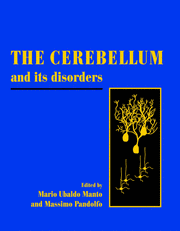Book contents
- Frontmatter
- Contents
- List of contributors
- Preface
- Acknowledgments
- Foreword by Sid Gilman
- PART I INTRODUCTION
- PART II THEORIES OF CEREBELLAR CONTROL
- PART III CLINICAL SIGNS AND PATHOPHYSIOLOGICAL CORRELATIONS
- PART IV SPORADIC DISEASES
- PART V TOXIC AGENTS
- PART VI ADVANCES IN GRAFTS
- PART VII NEUROPATHOLOGY
- PART VIII DOMINANTLY INHERITED PROGRESSIVE ATAXIAS
- PART IX RECESSIVE ATAXIAS
- 36 Friedreich's ataxia
- 37 Early-onset inherited ataxias
- 38 Ataxia telangiectasia and variants
- 39 Ataxia in mitochondrial disorders
- 40 Episodic ataxias as ion channel diseases
- Index
38 - Ataxia telangiectasia and variants
from PART IX - RECESSIVE ATAXIAS
Published online by Cambridge University Press: 06 July 2010
- Frontmatter
- Contents
- List of contributors
- Preface
- Acknowledgments
- Foreword by Sid Gilman
- PART I INTRODUCTION
- PART II THEORIES OF CEREBELLAR CONTROL
- PART III CLINICAL SIGNS AND PATHOPHYSIOLOGICAL CORRELATIONS
- PART IV SPORADIC DISEASES
- PART V TOXIC AGENTS
- PART VI ADVANCES IN GRAFTS
- PART VII NEUROPATHOLOGY
- PART VIII DOMINANTLY INHERITED PROGRESSIVE ATAXIAS
- PART IX RECESSIVE ATAXIAS
- 36 Friedreich's ataxia
- 37 Early-onset inherited ataxias
- 38 Ataxia telangiectasia and variants
- 39 Ataxia in mitochondrial disorders
- 40 Episodic ataxias as ion channel diseases
- Index
Summary
Introduction
Ataxia-telangiectasia (A-T) is an autosomal recessive, multisystem disorder with early-onset cerebellar ataxia as its most common defining neurologic feature. The constellation of accompanying extraneural features aids in its clinical diagnosis and includes conjunctival and cutaneous telangiectases, elevated levels of serum alphafetoprotein (AFP), chromosome aberrations, immunodeficiency with recurrent sinopulmonary infection, cancer susceptibility, and radiation hypersensitivity. Since identification of the causative gene, ATM (for ataxia-telangiectasia mutated), on chromosome 11q22-q23 (Gatti et al., 1988;Uhrhammer et al., 1995; Lange et al., 1995; Savitsky et al., 1995), the molecular basis of certain aspects of the disease have become clearer, although others remain to be elucidated (Gatti et al., 1991; Gatti, 2001).
Clinicopathologic syndrome
The earliest reports of an early-onset, familial, progressive choreoathetosis with ocular telangiectases (Syllaba and Henner, 1926) and of an early-onset, progressive cerebellar degeneration with cutaneous telangiectasia (thought to be a variant neurocutaneous syndrome) (Louis-Bar, 1941) did not recognize this as a distinct entity until the seminal clinicopathological studies of Boder and Sedgwick (1957) and of Biemond (1957), calling attention to the absence of the thymus gland and the prominence of severe recurrent sinopulmonary infections, the main cause of death (47% in one series: Sedgwick and Boder, 1991). A rapid succession of case reports confirmed the clinical syndrome of ‘ataxia-telangiectasia’ and also the presence of lymphoreticular malignancy as the second most frequent cause of death (22% malignancy alone, 26% malignancy with infection) (Boder and Sedgwick, 1963). It has proven to be the most common recessively inherited cerebellar ataxia in children under five years of age, with a prevalence of 1/40000–1/100000 live births (Swift, 1985; Swift et al., 1986).
- Type
- Chapter
- Information
- The Cerebellum and its Disorders , pp. 531 - 547Publisher: Cambridge University PressPrint publication year: 2001

